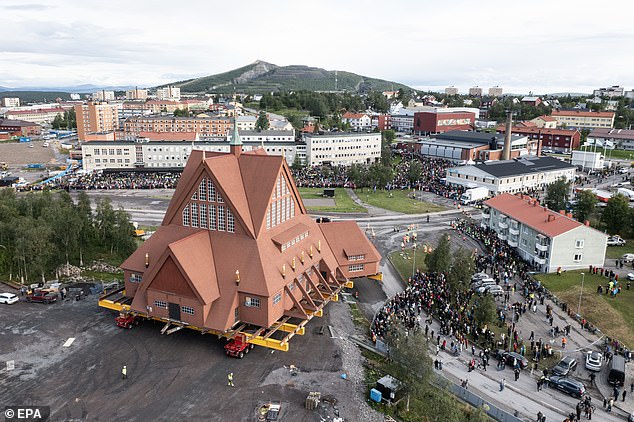A historic 670-tonne Swedish church has begun a two-day journey across a city to stop it sinking into a mine.
The 113-year-old Kiruna Church is slowly being moved across the arctic town on a vast convoy of trailers travelling at around 500 metres per hour.
Kiruna’s entire town centre is being relocated because of the giant LKAB iron ore mine that dominates the region, whose ever-deeper burrowing over the years has weakened the ground, increasing the risk of collapse in some parts.
Kiruna Kyrka, a Lutheran church from 1912, will travel five kilometres (three miles) on remote-controlled flatbed trailers to the new Kiruna town.
The complex and costly logistical operation began on Tuesday and was scheduled to be completed on Wednesday around 2.00 or 3.00pm (1200 or 1300 GMT).
The journey has so far gone smoothly for the 1,200-tonne convoy, but was expected to proceed more slowly on Wednesday due to some tricky narrow passages and 90 degree turns, officials said.

A historic 670-tonne Swedish church has begun a two-day journey across a city to stop it sinking into a mine

The 113-year-old Kiruna Church is slowly being moved across the arctic town on a vast convoy of trailers travelling at around 500 metres per hour

Kiruna’s entire town centre is being relocated because of the giant LKAB iron ore mine that dominates the region, whose ever deeper burrowing over the years has weakened the ground, increasing the risk of collapse in some parts

Kiruna Kyrka, an imposing 672-tonne Swedish Lutheran church from 1912, is being moved five kilometres (three miles) on remote-controlled flatbed trailers to the new Kiruna town
The move has generated widespread interest, with large crowds thronging the streets of the town of 18,000 people and Swedish television broadcasting the entire journey live.
King Carl XVI Gustaf was due to take part in festivities in Kiruna, including an attempt to break the world record for the number of people attending a ‘kyrkkaffe’, a church coffee break.
The town’s relocation process began almost two decades ago and is expected to continue for years to come.
The new town centre was officially inaugurated in September 2022.
The relocation of the church alone is expected to cost 500 million kronor ($52 million) and is being paid for by LKAB.
Designed by Swedish architect Gustaf Wickman, the church, which measures 40 metres (131 feet) tall, is a mix of influences and includes designs inspired by the region’s Indigenous Sami people on the pews.
The neo-Gothic exterior features slanting roofs and windows on each side, while its dark interior has elements of national romanticism as well as an Art Nouveau altarpiece and an organ with more than 2,000 pipes.
The church’s handblown glass windows were removed ahead of the move, replaced with plywood painted to look like windows.

The move has generated widespread interest, with large crowds thronging the streets of the town of 18,000 people and Swedish television broadcasting the entire journey live

King Carl XVI Gustaf was due to take part in festivities in Kiruna, including an attempt to break the world record for the number of people attending a ‘kyrkkaffe’, a church coffee break

The town’s relocation process began almost two decades ago and is expected to continue for years to come

Workers gather on the day Kiruna’s old wooden church is moved during a two-day relocation trip to a new site next to a cemetery in Kiruna, Sweden August 20, 2025
The belltower, which stood separately next to the church, will be moved next week.
Kiruna’s old church was voted the most beautiful building in Sweden in 2001.
The mission to move the entire city began in 2016 after the country’s state-controlled mining company alerted authorities in 2004 that recovering more iron ore from the Kiruna mine meant further excavation, destabilising the city’s centre.
Mining company Luossavaara-Kiirunavaara AB, or LKAB is Kiruna’s largest employer and the municipality started drawing up plans to relocate the city of 23,000.
‘It feels a bit nostalgic and a little sad,’ one resident, Mia Mörtlund, told Sveriges Radio at the time, reflecting the views of many residents who feel more sentimental about the old city than angry at the prospect of relocating to a new one.
‘For most people in Kiruna the fact that the town and its inhabitants will have to move is accepted as part of life,’ Mikael Stenqvist, an architect at White, told The Independent.
This article was originally published by a www.dailymail.co.uk . Read the Original article here. .

